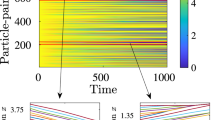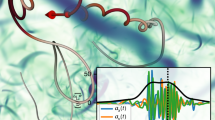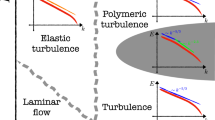Abstract
THE central problem of fully developed turbulence is the energy-cascading process. It has resisted all attempts at a full physical understanding or mathematical formulation. The main reasons for this failure are related to the large hierarchy of scales involved, the highly nonlinear character inherent in the Navier–Stokes equations, and the spatial intermittency of the dynamically active regions. Richardson1 has described the interplay between large and small scales with the words 'Big whirls have little whirls which feed on their velocity ... and so on to viscosity", and the phenomenon so described is known as the Richardson cascade. This local interplay also forms the basis of a theory by Kolmogorov2. It was later realized that the cascade ought to be intermittent, and Mandelbrot3 has given a fractal description of the intermittency of the fine structure. A particular case that emphasizes the dynamical aspect of the fractal models is the β-model4, in which the flux of energy is transferred to only a fixed fraction β of the eddies of smaller scales. More recently, a multifractal model of the fine-scale intermittency has been introduced by Parisi and Frisch5; this accounts for the more complex cascading process suggested by the experimental data on inertial-range structure functions obtained by Anselmet et al.6. These statistical models are insufficient, however, because they cannot give any topological information about the intermittent structures in real space. Here we use the wavelet transform7 to analyse the velocity field of wind-tunnel turbulence at very high Reynolds numbers8. This 'space-scale' analysis is shown to provide the first visual evidence of the celebrated Richardson cascade1, and reveals in particular its fractal character3. The results also indicate that the energy-cascading process has remarkable similarities with the deterministic construction rules of non-homogeneous Cantor sets9,10.
This is a preview of subscription content, access via your institution
Access options
Subscribe to this journal
Receive 51 print issues and online access
$199.00 per year
only $3.90 per issue
Buy this article
- Purchase on Springer Link
- Instant access to full article PDF
Prices may be subject to local taxes which are calculated during checkout
Similar content being viewed by others
References
Richardson, L. F. Weather Prediction by Numerical Process (Cambridge Univ. Press, 1922).
Kolmogorov, A. N. C. r. Acad. Sci. USSR 30, 301–358 (1941).
Mandelbrot, B. B. J. Fluid Mech. 62, 331–358 (1974).
Frisch, U., Sulem, P. L., & Nelkin, M. J. Fluid Mech. 87, 719–736 (1978).
Parisi, G. & Frisch, U. in Turbulemce and Predictability in Geophysical Fluid Dynamics and Climate Dynamics (eds Ghil, M., Benzi, R. & Parisi, G.) 71–88 (North-Holland, Amsterdam, 1985).
Anselmet, F., Gagne, Y., Hopfinger, E. J. & Antonia, R. A. J. Fluid Mech. 140, 63–89 (1984).
Grossmann, A. & Morlet, J. in Mathematics and Physics, Lecture on Recent Results (ed. Streit, L.) (World Scientific, Singapore, 1987).
Gagne, Y. thesis, Univ. of Grenoble (1987).
Arnéodo, A., Grasseau, G. & Holschneider, M. Phys. Rev. Lett. 61, 2281–2287 (1988); Arnéodo, A., Grasseau, G. & Holschneider, M. in Wavelets (eds Combes, J. M., Grossmann, A. & Tchamitchian, P.) (Springer, Berlin, in the press).
Holschneider, M. J. stat. Phys. 50, 963–993 (1988).
Goupillaud, P., Grossmann, A. & Morlet, J. Geoexploitation 23, 85–102 (1984).
Kronland-Martlinet, R., Morlet, J. & Grossmann, A. Int. J. Pattern Recognition and Artificial Intelligence, spec. Iss. on Expert Systems and Pattern Analysis (in the press).
Daubechies, I., Grossmann, A. & Meyer, Y. J. math. Phys. 27, 1271–1283 (1986).
Grossmann, A., Morlet, J. & Paul, T. J. math. Phys. 26, 2473–2479 (1985).
Arnéodo, A., Argoul, F., Elezgaray, J. & Grasseau, G. in Nonlinear Dynamics (ed. Turchetti, G.) (World Scientific, Singapore, (in the press)).
Farge, M. & Rabreau, G. C. r. Acad. Sci. Paris 307, Ser. II, 1479–1488 (1988).
Gagne, Y., Hopfinger, E. J. & Frisch, U. in New Trends in Nonlinear Dynamics and Pattern Forming Phenomena: The Geometry of Non-Equilibrium (eds Huerre, P. & Coullet, P.) (Plenum, New-York, 1988).
Author information
Authors and Affiliations
Rights and permissions
About this article
Cite this article
Argoul, F., Arnéodo, A., Grasseau, G. et al. Wavelet analysis of turbulence reveals the multifractal nature of the Richardson cascade. Nature 338, 51–53 (1989). https://doi.org/10.1038/338051a0
Received:
Accepted:
Issue Date:
DOI: https://doi.org/10.1038/338051a0
This article is cited by
-
Stochastic Parametrization of the Richardson Triple
Journal of Nonlinear Science (2019)
-
Analysis of Intermittency in Submillimeter Radio and Hard X-Ray Data During the Impulsive Phase of a Solar Flare
Solar Physics (2016)
-
Tissue multifractality and Born approximation in analysis of light scattering: a novel approach for precancers detection
Scientific Reports (2014)
-
Multifractal analysis of inclined oil-water countercurrent flow
Petroleum Science (2014)
-
Thin Shear Layer Structures in High Reynolds Number Turbulence
Flow, Turbulence and Combustion (2014)
Comments
By submitting a comment you agree to abide by our Terms and Community Guidelines. If you find something abusive or that does not comply with our terms or guidelines please flag it as inappropriate.



